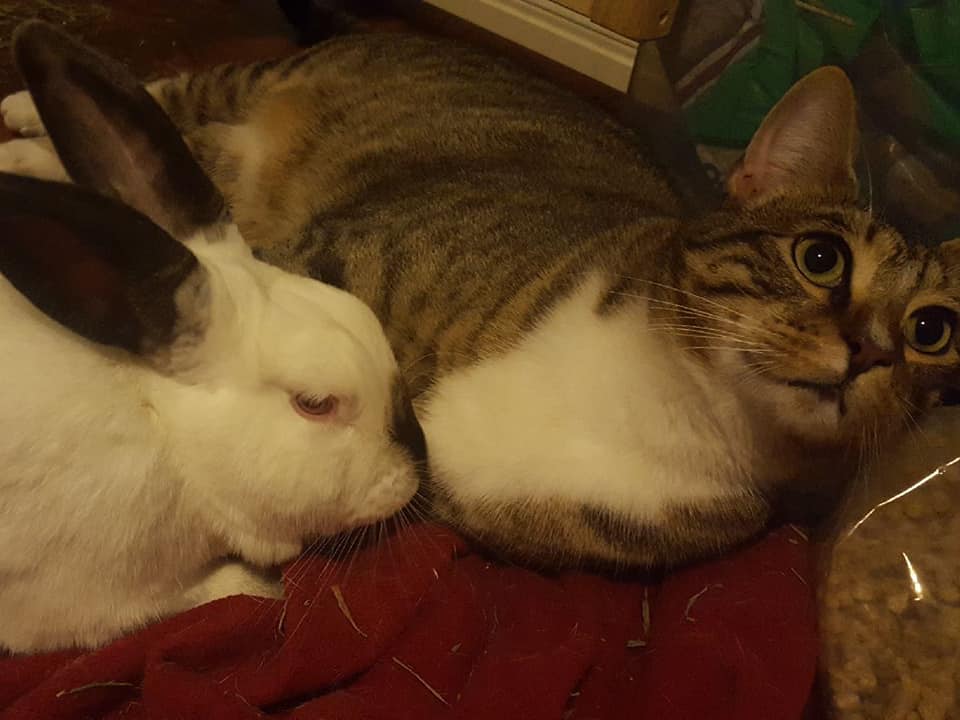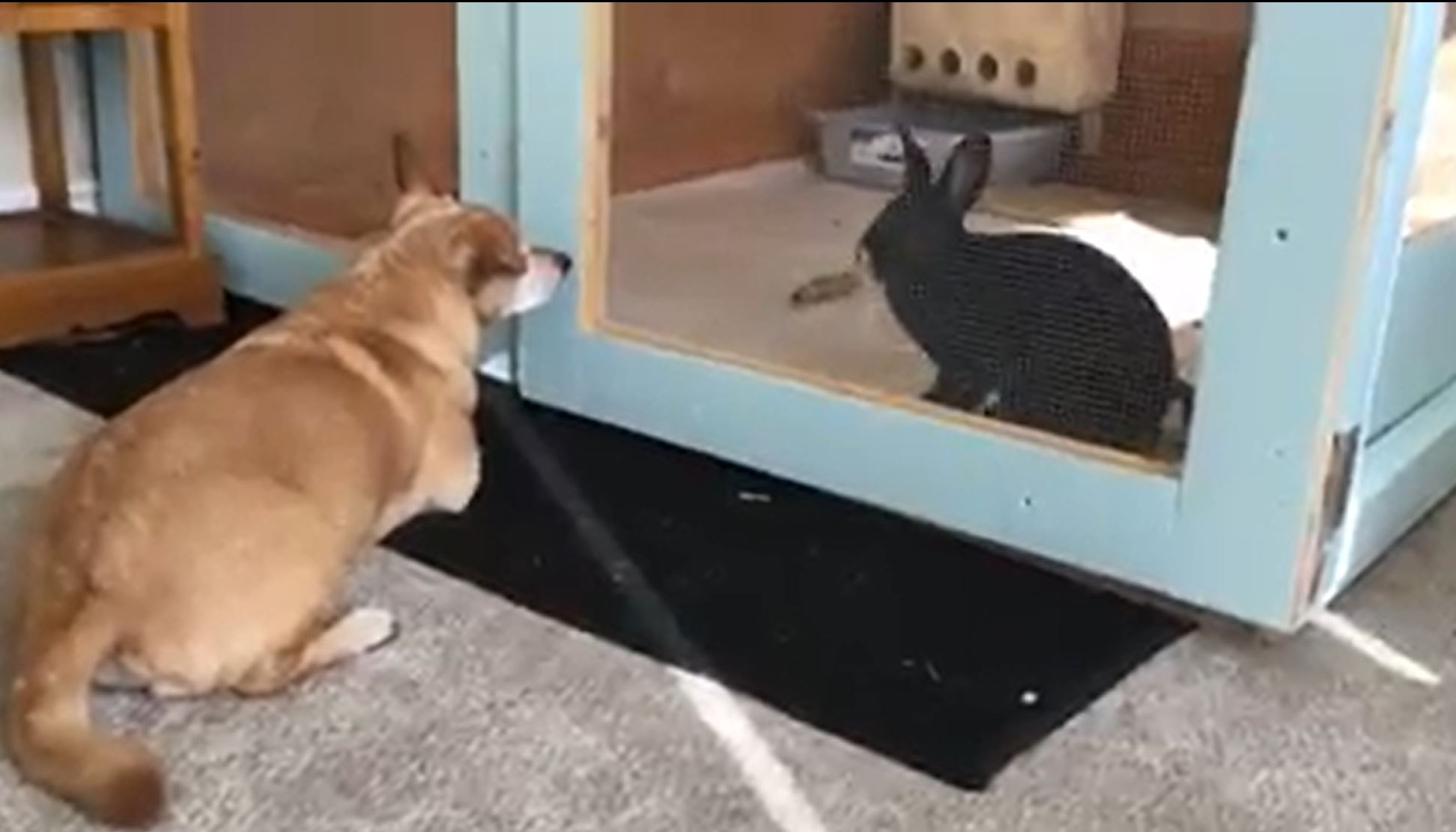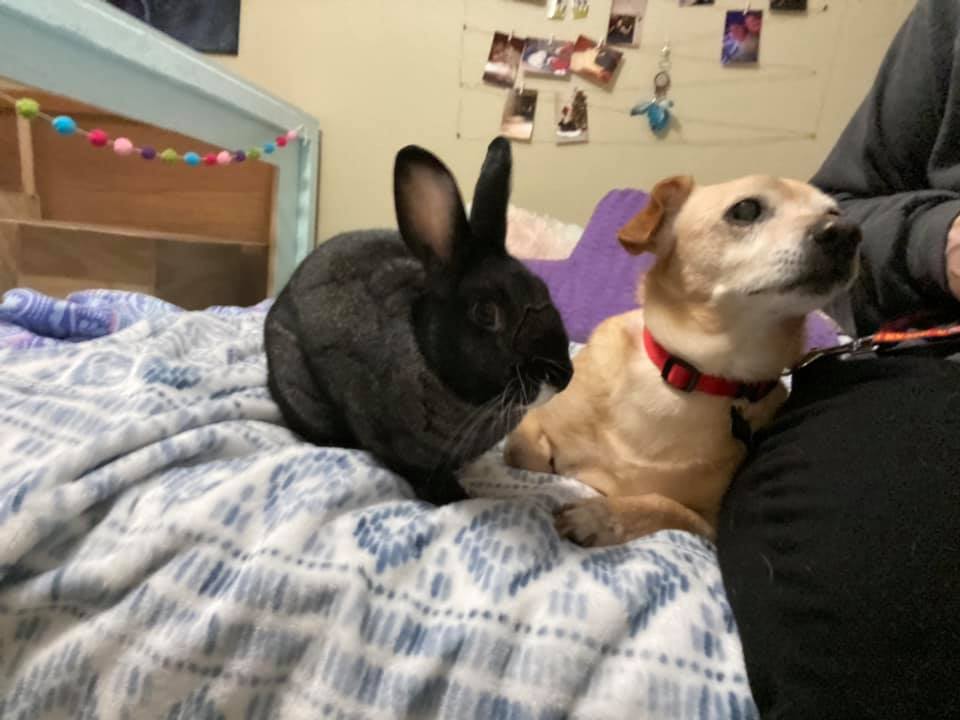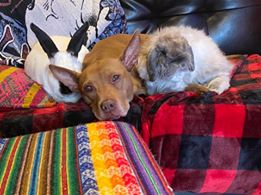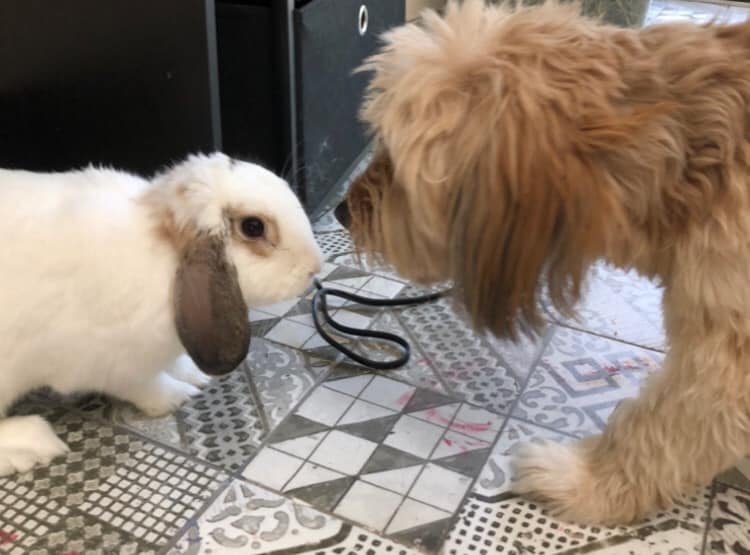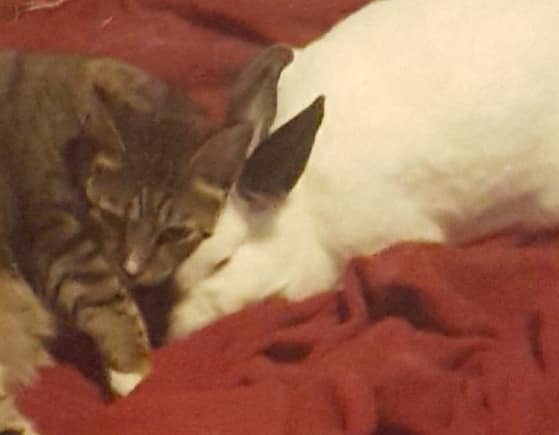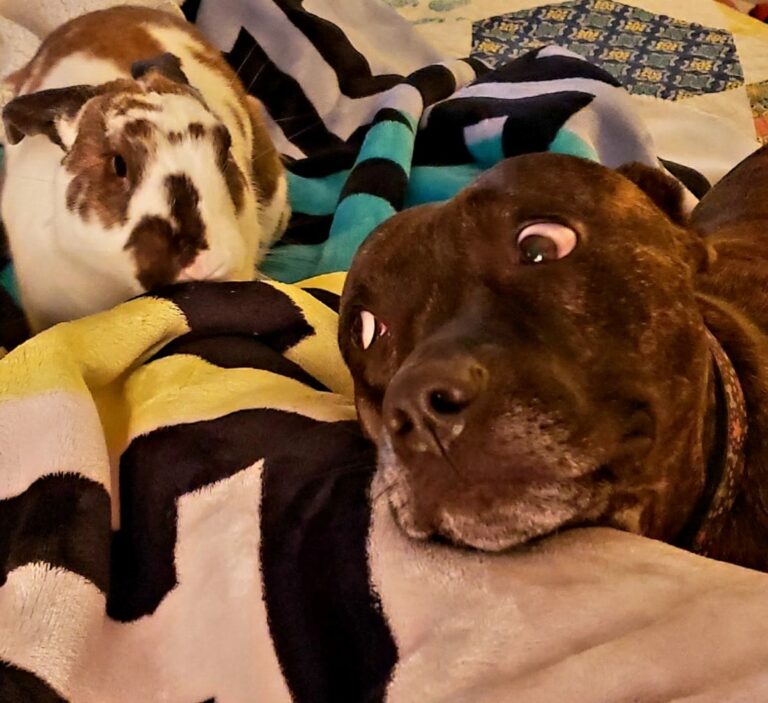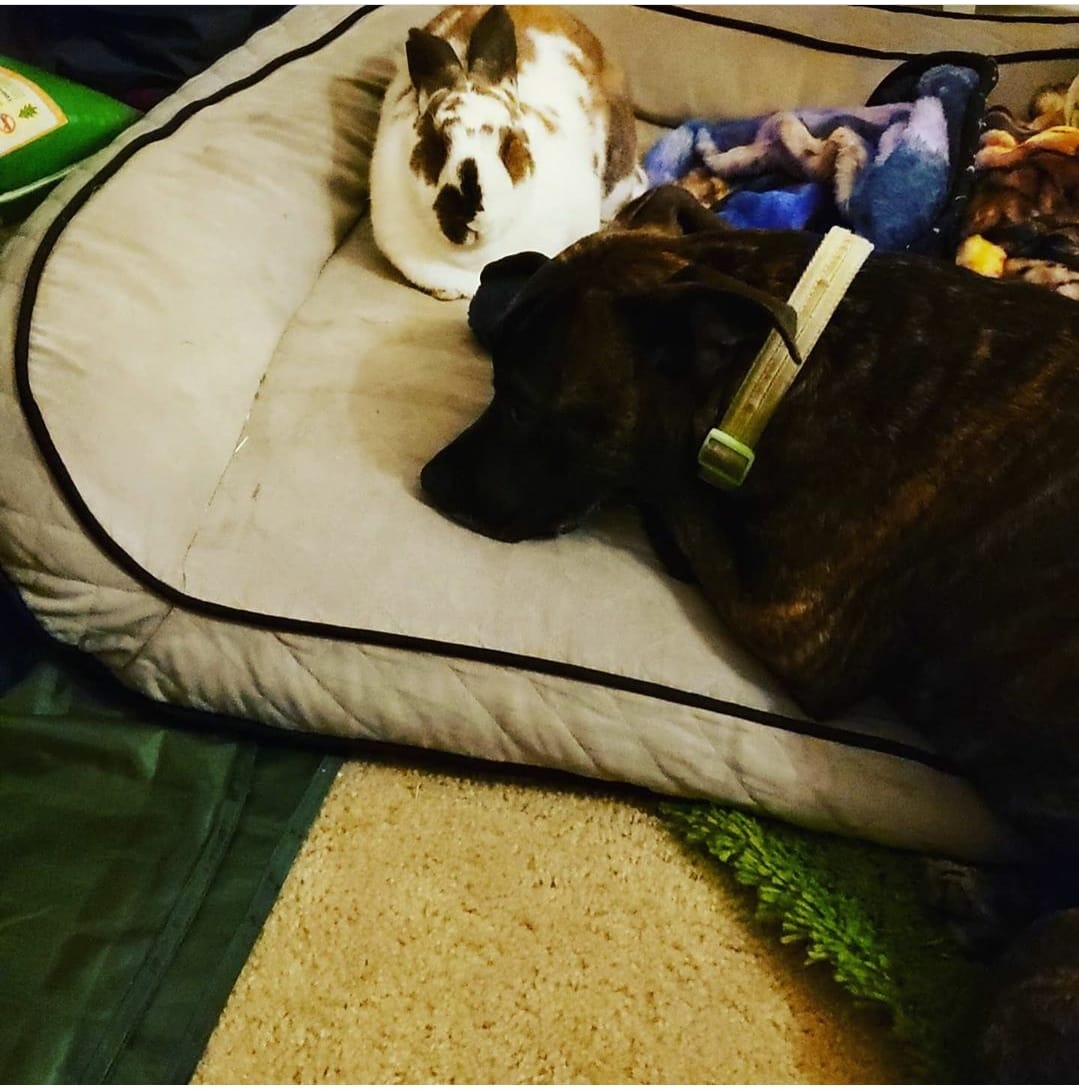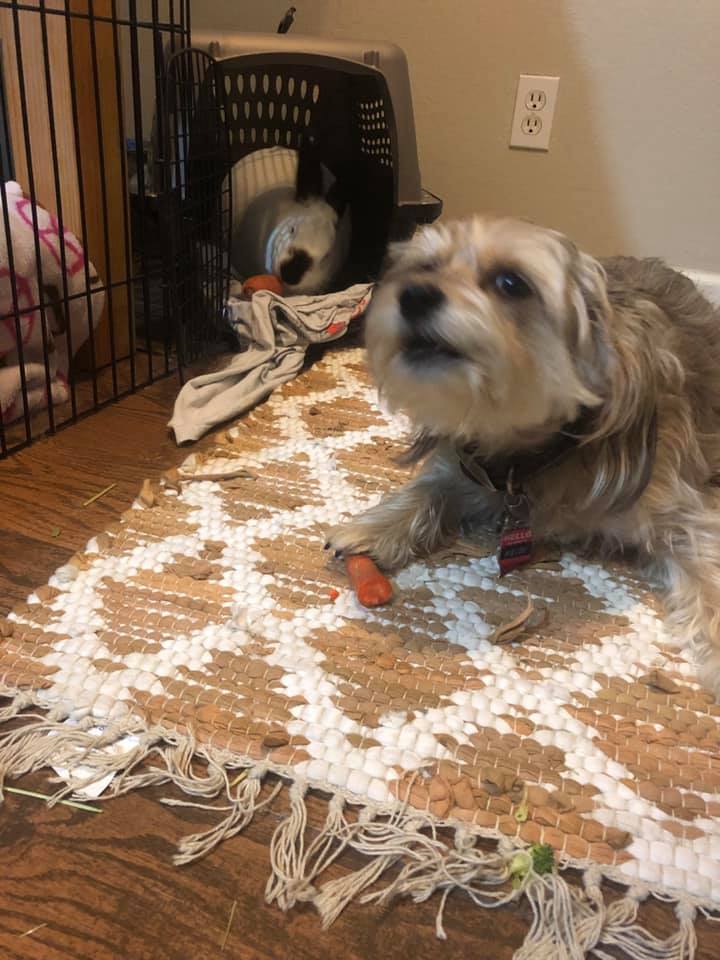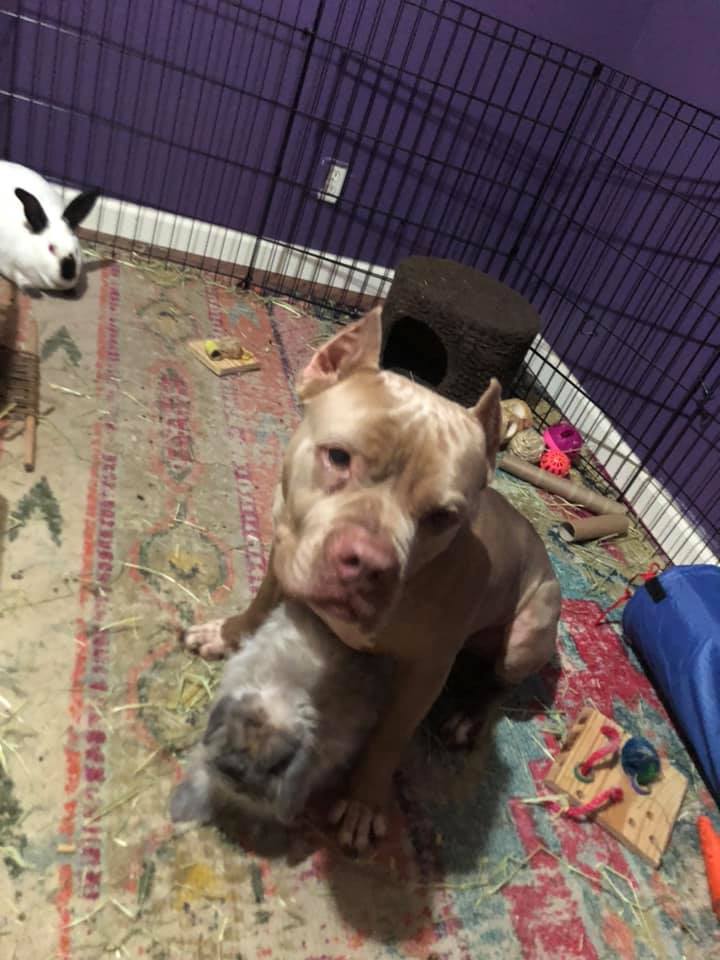Housing for Rabbits
Rabbits and Other Animals
Watch as rabbit expert Mary E. Cotter and bunny lover and actress Amy Sedaris discuss how rabbits and other pets get along.
On This Page:
Rabbits and Other Animals
Questions to Ask Yourself
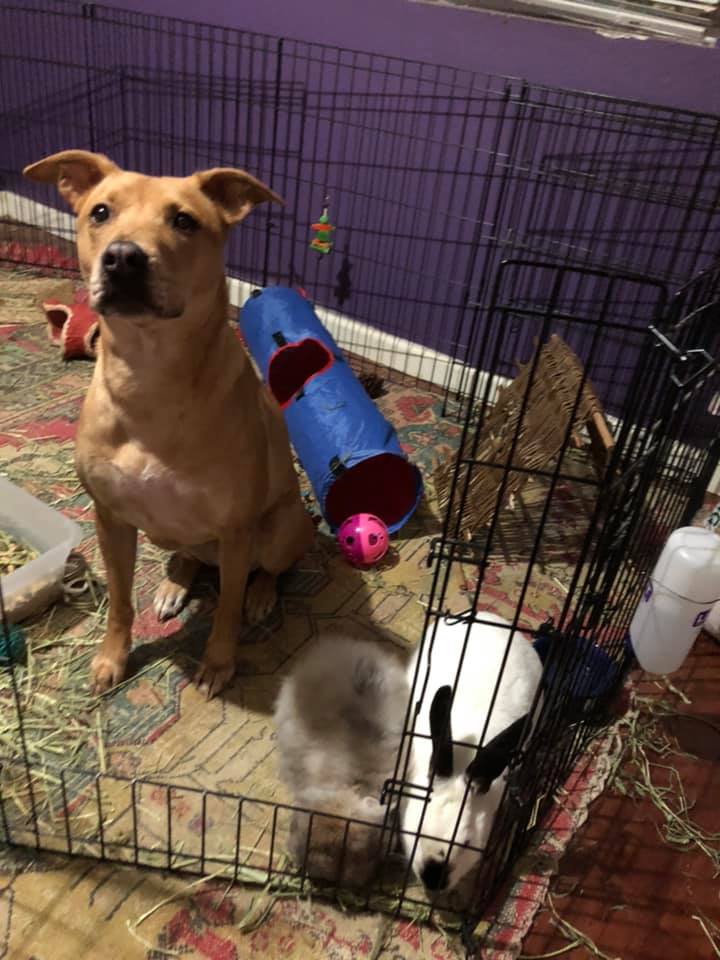
Dog Ozzy and his friends HRRN Alumni Pasadena and Oliver. Their adopter worked slowly and consistently to introduce each of her dogs to the rabbits with great success.
Questions to Ask Yourself About Your Pet
Does my dog or cat like to chase things?
Does your dog love to chase squirrels or wild rabbits around the yard or park? Are outings with your dog chaotic due to their wanting to chase any animal they see? If you answered yes to either of these questions, your dog may have strong prey drive.
Is my dog well trained? Does he respond to all of my commands?
A well-trained dog makes all the difference when overcoming a high prey drive. If your dog’s prey drive is high but you’re hoping to overcome it and still get a rabbit, training is essential. Your dog must be able to listen and do as you command each time you request something of them. This level of training is not always easily accomplished. Taking your dog to a professional dog trainer for a short time may be the best thing for everyone.
Is my dog's breed a high prey drive breed?
Is my dog aggressive, or do they have a strong prey-drive? Does it matter which is which?
Look for these key traits in your dog before introducing to a rabbit:
- Low prey drive is REQUIRED-either naturally or trained
- Dog follows basic commands such as ‘sit’, ‘down’, ’stay’, and ‘leave it’
- Calm, submissive dog
- Adult dog (puppies are untrained and unable to control their exuberant behavior)
- Breed recommendations are generalities to use as a baseline. Individual personalities are most important to determine compatibility.
- A trained service dog or therapy dog
Rabbits and Other Animals
Introducing Your Rabbit to Your Dog
Dogs and rabbits have the ability to live happily and peacefully in the same home. But that ability all boils down to your dog’s prey drive. After thoroughly assessing your dog’s personality and prey-drive level, and you feel they’re able to coexist with a prey animal such as a rabbit, then it’s time for introductions.
If your dog did not “pass” the questions or meet the personality traits listed above, we urge you to proceed with extreme caution. If your dog did not pass the above questions but you have a rabbit, it would be best for everyone to keep the rabbit in a separate room from the dog. Possibly permanently. It is better to be safe instead of sorry.
Shannon McCauly with Best Friends Training visited House Rabbit Resource Network and spoke to us about how to introduce our rabbits to our other favorite companions, dogs. Learn how to safely and successfully introduce all of your furry family members.
If your dog does not match these traits, that doesn’t mean they’re a bad dog by any means. Dogs are predators, rabbits are prey. Many dogs simply cannot separate their instinctual need to hunt from their owner’s orders not to kill that specific fluff-ball that suddenly appeared in their house two days ago.
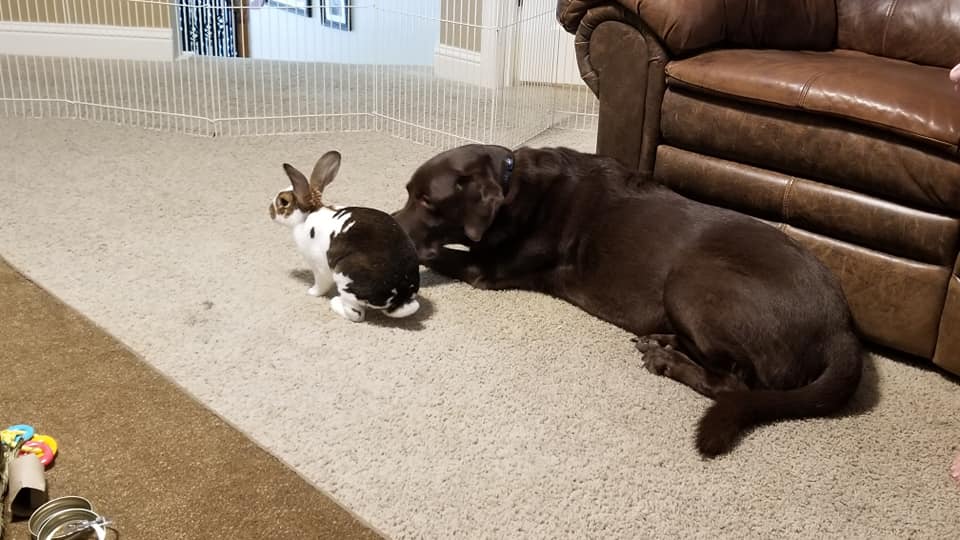
Rabbits and Other Animals
Introduction Steps:
- Find a Neutral Space: Locate a space in your home that is not frequently used or occupied by either animal. It should be a space in which you can control the interactions easily. This will reduce or eliminate any territorial behavior.
- Secure the Rabbit in a Safe Enclosure: Place the rabbit in a crate or cage before bringing it to the neutral space. Allow the rabbit to acclimate there for half an hour or more before you introduce the dog into the space. If the rabbit is showing signs of stress, delay, or postpone the introduction process for as long as a day or two. Signs that a rabbit is stressed include: biting the cage/crate bars, overgrooming, displaying altered feeding or toileting behavior, and/or repeatedly circling the enclosure.
- Secure the Dog: Secure the dog with a leash attached to its collar or to a front-clipping harness before entering the introduction space.
- Ask for Help: Ask a family member or friend to help by holding your dog. You want the most supervision possible and having an extra set of hands and eyes will work to your advantage.
- Introduce the Rabbit and Dog Slowly: Do not introduce the dog and rabbit too fast. The rabbit will have been placed in its cage in the neutral space ahead of time. Bring the dog into the space slowly and allow the dog to investigate the rabbit in its crate–visually and through smell. The dog must still be on the leash for the initial introduction. Don’t make sudden moves or allow them access to one another too quickly.
- Once again, watch the rabbit for signs of stress or distress. If the rabbit is kicking, breathing hard, or trying to escape, then remove the dog from the room and let the rabbit calm down.
- Keep in mind that, if the rabbit stops moving altogether, is hunkered down and “frozen”. This may also indicate a reluctance or refusal to interact or accept interaction from the dog.
- By the same token, make sure the dog is not stressed or even over-excited. If you observe either of these behaviors in the dog, postpone the introduction until the dog is in a calmer state.
- Keep an Eye on Them: Under no circumstances are the rabbit and dog allowed to be left together without supervision.
- Keep Sessions Short: Don’t push your luck by allowing the introduction period to get too long. Keep the introduction sessions short… no more than 10 minutes. Longer exposure to one another will increase the potential for the dog to get too excited or the rabbit to begin getting stressed.
- Practice the Routine: Your pets may not hit it off right away, and that’s okay. Practice introducing your pets to each other until it becomes a routine. Eventually, your pets will get used to seeing and smelling each other.
- Separate Feeding Areas: It is best to separate your dog and rabbit during meal times or when/if food is around. Heightened stress levels or over-excitement can be distracting, intrusive, or stressful and may create negative associations with food.
Rabbits and Other Animals
When the Rabbit and Other Animals Aren't Getting Along
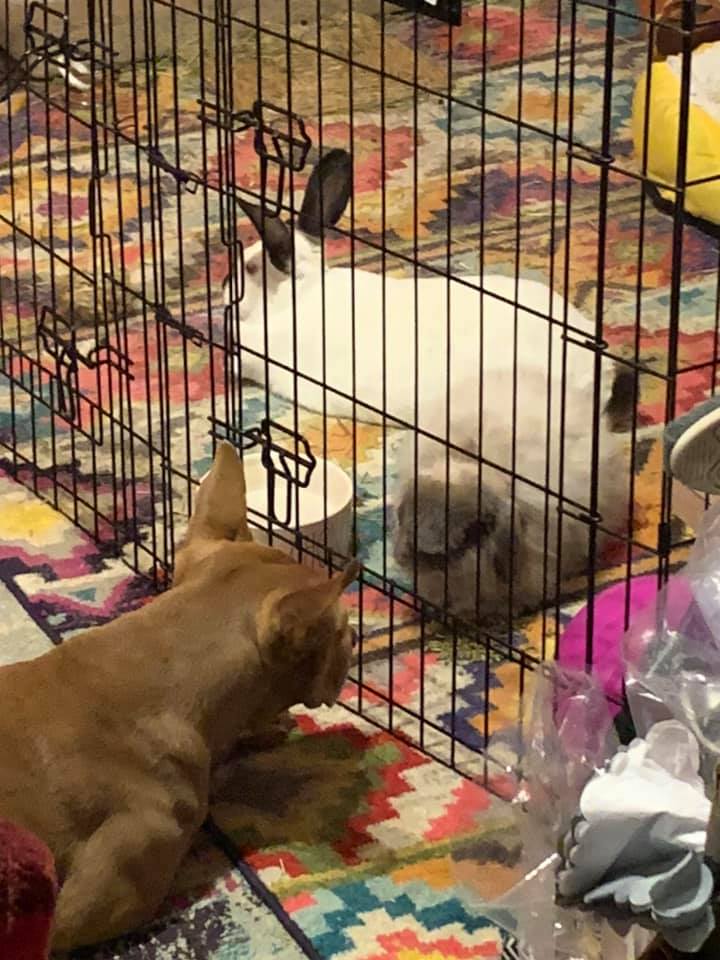
Rabbits and Other Animals
Rabbits and Cats
Rabbits and Other Animals
Frequently Asked Questions
My dog is ______ breed. Are they good with rabbits?
There are certain breeds that are more likely to have high-prey drives, and therefore are more likely to have difficulties coexisting with a rabbit. However, each animal is an individual, so you cannot simply say: any dog in this breed can’t get along with a rabbit, or vice versa. You’ll need to assess your dog with the questions up above to get a better understanding of your dog’s individual predatory drive.
With that being said, here is a database of dog breeds with information that can be useful: Dog Breeds
How do I help my rabbit to feel less anxious and get along with an 8 week old puppy? The puppy is fine with the rabbit but my rabbit isn’t at all. I’m not sure how to help reduce the anxiety
As each animal is an individual, some rabbits will never feel safe around a dog. That being said, the anxiety could very well be coming from the over-the-top hyper puppy energy. Obedience training with the puppy before introduction is key. Possibly get a dog trainer to assist. Once the puppy has all their commands memorized, then you can consider trying to introduce again via the above introduction steps.
My dog is good with small dogs and cats and was good with bunnies but out of the blue now she wants to kill my rabbit and nothing I do is helping. Any suggestions? I don’t want to rehome either of them.
This is a tough situation. Something obviously triggered the dog. We recommend reaching out to a dog trainer to do an assessment. There could be something in the environment setting the dog off that the trainer can find and help remove or train around. But until then you need to separate the dog and rabbit.
If I already own a rabbit and want to get a young dog, what safety precautions do I take to make their bond work?
Dog obedience training is key to successful introductions, as well as the personality assessment for level of prey-drive. If the dog is deemed to be on the low-prey drive side, and once they respond immediately to all obedience commands, you can begin the introduction steps above.
Rabbits and Other Animals
Further Reading and Resources
Rabbits and Other Animals
Adopter Photos!
We wanted to share some of our adopters and volunteers photos of their rabbits and other animals. We love seeing this happy relationships and we hope you enjoy them too!

